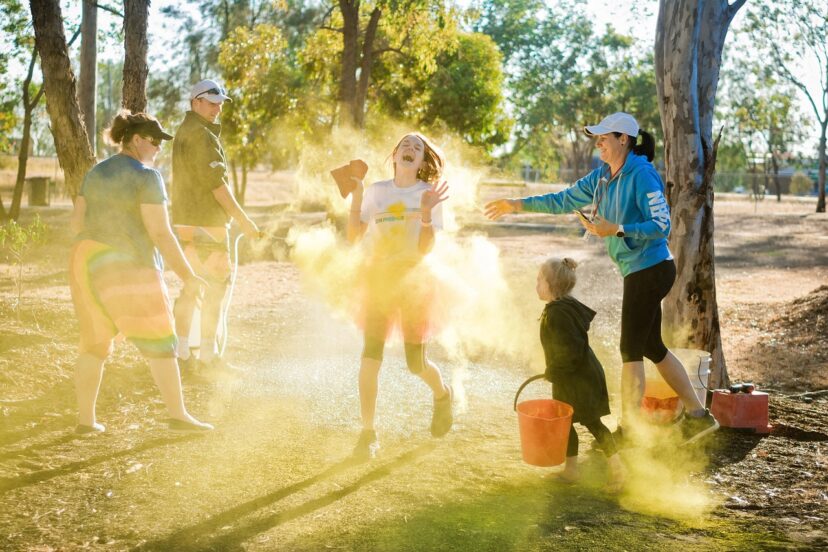Backyard Games: Building Family Memories
*We may earn a commission for purchases made using our links. Please see our disclosure to learn more.
The laughter of children racing across the lawn. The gentle ribbing between siblings during a competitive round of horseshoes. The triumphant cheer of grandpa after scoring the winning point in cornhole. These are the sounds that have filled my backyard for years, creating a tapestry of memories that bind our family together across generations. When I think back to our most cherished family moments, they aren’t from expensive vacations or elaborate events—they’re from those simple Sunday afternoons when we gathered in our backyard, armed with nothing more than a few simple games and the desire to spend quality time together.
Backyard games have become the heartbeat of our family gatherings. They’ve transformed ordinary get-togethers into extraordinary memory-making opportunities. Through trial and error, laughter and friendly competition, I’ve discovered that the right selection of backyard games can break down age barriers, spark conversation, encourage physical activity, and foster the kind of deep connection that modern families often struggle to maintain in our digital world.
In this article, I’ll share my journey of discovering how backyard games revolutionized our family gatherings, the specific games that became instant classics for us, and practical advice on creating your own outdoor game paradise. Whether you have a sprawling lawn or a modest patio, a family of athletic competitors or relaxed participants, I promise there’s a backyard game tradition waiting to transform your family gatherings too.
“Play gives children a chance to practice what they are learning… Play is the work of childhood, but it’s also the forgotten necessity of adulthood. It connects us to others and to our better selves.”
— Fred Rogers, Television Host and Child Development Expert
Key Takeaways
- Intentional game selection can bridge generational gaps and create inclusive fun for family members ages 5 to 95
- Rotating game stations prevents boredom and ensures everyone finds something they enjoy
- Weather-resistant games extend your outdoor playing season beyond just summer months
- DIY game options provide budget-friendly alternatives to expensive store-bought versions
- Tournament-style play adds excitement and creates traditions your family will look forward to year after year
Recommended Products for Backyard Fun
GoSports Splash Hoop PRO Swimming Pool Basketball Game
Make a splash at your next pool party with the GoSports Splash Hoop PRO! This high-quality, freestanding pool basketball hoop brings the excitement of basketball to your swimming pool. Featuring a sturdy 34” x 25” backboard and a 14” rim, the Splash Hoop PRO is engineered to withstand the demands of poolside play. Whether you're hosting a family gathering or just relaxing by the water, this game is perfect for all ages. The set includes 2 inflatable water basketballs and a ball pump, so you're ready to start playing immediately. With its fast setup, weighted base for added stability, and modern design, the Splash Hoop PRO is the ultimate summer game.
This durable, height-adjustable poolside basketball hoop brings the excitement of basketball into your swimming pool. Perfect for family members of all ages, it features a weighted base for stability and comes with waterproof basketballs.
- Durable Design: Made from engineered wood and alloy steel to handle poolside play.
- Quick Setup: Fast assembly with a weighted base for stability.
- Complete Set: Includes 2 inflatable balls and a pump, ready for fun.
- Water-Only Use: Best suited for pools, not adaptable for other surfaces.
- Requires Filling: The base must be filled with water for secure placement.
- Size: Larger setup may not be suitable for smaller pools.
Elite Sportz Ring Toss Game Set for Kids & Adults
The Elite Sportz Ring Toss is a classic outdoor game that brings hours of fun for kids, families, and friends! Perfect for birthdays, barbecues, or casual backyard games, this easy-to-play game helps children improve their hand-eye coordination and motor skills while having a blast outdoors. The set includes 5 durable rope rings and a sturdy wooden base with score markings, making it ideal for both kids and adults alike. Whether you're in the yard, at the beach, or on a camping trip, this portable game ensures endless entertainment wherever you go.
This premium wooden ring toss set includes 8 rope rings with varying difficulties. The compact design makes it portable for picnics and family gatherings while offering entertaining competition for all skill levels.
- Durable Construction: Built with a sturdy wooden base and durable rope rings for lasting use.
- Portable Fun: Compact and easy to transport to beaches, parks, or camping trips.
- Skill Development: Encourages hand-eye coordination, motor skills, and social interaction.
- Size Limitations: Smaller rings may be challenging for very young children under 4.
- Outdoor Use: Best played outside; not ideal for indoor environments.
- No Storage for Rings: Rings are not attached to the base, so storage may require a small bag or container.
Franklin Sports Outdoor Croquet Set – 6 Player
Bring the fun of classic croquet to your backyard with the Franklin Sports 6 Player Outdoor Croquet Set. Perfect for family gatherings, barbecues, or casual outdoor games, this set includes everything you need to start playing. The durable, all-weather croquet balls and color-coordinated wooden mallets ensure lasting performance, while the steel wickets and colorful scoring sticks keep the game organized. When you're done playing, store everything conveniently in the included wooden stand. Whether you're a beginner or a seasoned player, this vintage-inspired croquet set offers endless outdoor fun for all ages.
This complete set includes everything needed for six players to enjoy this classic lawn game. With weather-resistant materials and carrying case, it’s perfect for multi-generational play and can be set up in minutes.
- Complete Set: Includes all necessary components—balls, mallets, wickets, and scoring sticks.
- Durable Construction: Built with all-weather materials to withstand outdoor play.
- Convenient Storage: Comes with a wooden stand to keep everything neatly organized when not in use.
- Large Size: May require a larger backyard space for comfortable play.
- Assembly Required: Mallets need to be assembled by screwing heads onto handles.
- Weight: Heavier set may not be as portable for those with limited storage space.
GoSports Ladder Toss Game Set
The GoSports Ladder Toss Game Set is the ultimate way to enjoy outdoor or indoor fun with family and friends. Available in Pro and Classic styles, this set features ultra-durable, reinforced PVC targets that can withstand hours of play. The set includes 2 ladder toss targets, 6 soft rubber bolos (3 red, 3 blue), a convenient carrying case, and easy-to-follow game rules. Perfect for tailgates, cookouts, campsites, or family gatherings, this ladder toss set is designed for simplicity, fun, and portability. Its soft rubber bolos are kid-friendly and tangle-resistant, making it ideal for players of all ages!
This fun and easy-to-assemble GoSports Ladder Toss game features soft rubber bolos in two vibrant colors, a foldable design for effortless storage, and a convenient carrying case for portability. Lightweight enough for kids to join in on the setup, yet durable enough for competitive play, it’s perfect for backyard gatherings, tailgates, or family fun.
- Durable Construction: Reinforced PVC targets are built to withstand frequent use.
- Complete Set: Includes targets, bolos, a carrying case, and rules for easy play.
- Kid-Friendly: Soft rubber bolos ensure safe play indoors or outdoors.
- Assembly Required: Some minor setup required despite pre-assembly.
- Size: Larger targets may take up space for indoor play.
- Weather Resistance: The set is suitable for outdoor use but should be stored indoors during bad weather.
My Journey into Backyard Game Enthusiasm
I never set out to become our family’s “game master.” The role found me gradually, born from necessity rather than choice. Five years ago, we hosted our annual summer family reunion—twenty-three people spanning four generations crammed into our modest home. The weather was perfect, but as I watched the adults disappear into their phones and the cousins retreat into their separate age groups, I felt a pang of disappointment. This wasn’t the connected family experience I’d envisioned.
In a moment of desperation, I dragged out an old cornhole set from the garage, set it up on the lawn, and casually challenged my phone-absorbed brother to a game. What happened next was nothing short of magical. His competitive spirit kicked in. My nieces wanted to try. Soon my elderly father, who rarely participated in physical activities due to his arthritis, was giving pointers on technique. Within thirty minutes, we had a tournament brewing, complete with playful trash talk and impromptu cheering sections.
“I hadn’t seen dad laugh like that in years,” my sister whispered as we watched him high-five his grandson after a particularly impressive toss. That simple observation hit me like a revelation—we’d been overthinking family connection. Sometimes all it takes is a bean bag and a target to bring people together.
The Transformation Power of Outdoor Play
That cornhole revelation sparked what became an obsession with finding games that could recreate that magical moment of connection. I started small, investing in classics like horseshoes and bocce ball. Each new addition to our game collection taught me something important about what makes a great family backyard game:
Inclusivity is non-negotiable. The best games offer modifications for different ages and abilities. When my nephew brought giant Jenga to our Labor Day cookout, we discovered that my 89-year-old grandmother became our secret weapon. Her steady hands, honed through decades of needlework, made her unbeatable. The pride on her face when the teenagers begged to have her on their team was priceless.
Weather-resistance extends your playing season. After losing an entire box of playing cards to an unexpected summer shower, I learned to invest in games with durable materials. Our water-resistant molded plastic checkers set has survived three summers of spilled drinks, sudden downpours, and being accidentally left outside overnight more times than I care to admit.
Storage matters more than you think. My initial enthusiasm led to game equipment overtaking our garage. Now I prioritize games that pack flat or serve dual purposes. Our outdoor coffee table cleverly conceals a chess/checkers board, while our ottoman houses lawn darts and flying discs.
Games That Became Family Favorites
Through years of trial and error, certain games have earned permanent status in our backyard rotation. Here are the three that transformed our gatherings most dramatically:
Kubb: The Viking Chess Revolution
I discovered Kubb (pronounced “koob”) after researching traditional European yard games. This Swedish game, sometimes called “Viking Chess,” involves throwing wooden batons to knock over wooden blocks. The simple premise belies the strategy involved, making it perfect for mixed ages.
When I introduced it at my daughter’s graduation party, I was unsure how it would be received—the wooden pieces seemed too simple in our age of electronic entertainment. Yet something about the satisfying thunk of wood hitting wood and the easy-to-grasp but difficult-to-master rules created immediate engagement.
“It’s like bowling and chess had a baby,” my uncle declared after his third consecutive game. The natural breaks between throws created space for conversation, and the team-based play fostered unlikely alliances. My typically shy nephew found himself strategizing with his extroverted cousins, their shared goal of victory temporarily erasing their personality differences.
Setting up our first tournament required some planning—I created a simple bracket on poster board and offered a goofy trophy (a wooden spoon spray-painted gold). That small addition of competitive structure transformed casual play into an eagerly anticipated tradition. Three years later, the “Golden Kubb” trophy remains one of our most fiercely contested family honors.
Giant Connect Four: Scaling Up Childhood Nostalgia
The oversized version of this childhood classic became our family’s unexpected hit during a rainy weekend when outdoor options were limited to our covered patio. The four-foot version I purchased online seemed expensive at the time, but has more than justified its cost through countless hours of intergenerational play.
What makes giant Connect Four particularly special is its ability to level the playing field. Strategic thinking matters more than physical ability, allowing my math-minded father-in-law to compete equally with his athletic grandsons. The simple rules mean even young children can participate meaningfully, while the strategic depth keeps adults engaged beyond mere courtesy.
We discovered an unexpected benefit when my sister’s children, who struggle with attention issues, showed remarkable focus during Connect Four tournaments. The tactile nature of sliding the large discs into place and the immediate visual feedback seemed to help them concentrate in ways that smaller tabletop games couldn’t match.
“I’ve never seen him sit still for that long,” my sister remarked after her son played seven consecutive games with his grandfather. That connection across generations—watching them lean into their shared concentration, plotting moves together—remains one of my favorite family gaming memories.
Spikeball: Energy Release for Active Families
Not every backyard game creates gentle, contemplative moments. Sometimes you need an outlet for the boundless energy of teenagers and the competitive fire of adults. Enter Spikeball, the fast-paced 360-degree game that combines elements of volleyball and four-square on a circular net.
I’ll admit I resisted this one initially. The intensity seemed at odds with our usual inclusive approach. Would grandparents feel excluded? Would younger kids get frustrated? My concerns proved unfounded when we established a modified “family rules” version alongside the standard game. We created a designated area where the more competitive family members could play by official rules, while our adapted version in another part of the yard featured softer balls and relaxed rules about double-hits.
The physical nature of Spikeball offered something our other games didn’t—a legitimate workout disguised as play. After months of pandemic restrictions had left many of us more sedentary than usual, watching my brother and his teenage sons diving dramatically for saves reminded me of the pure joy of movement.
“I haven’t moved like that since high school,” my brother panted after a particularly competitive round. The sweat-soaked smiles and breathless laughter became a different kind of connection—the shared experience of physical exertion and the natural endorphin boost that comes with it.
Overcoming Backyard Game Challenges
Creating our backyard game paradise wasn’t without obstacles. Limited space initially seemed like a dealbreaker for many games until we got creative with modifications. Our narrow side yard became the perfect horseshoe pitch when we switched to rubber horseshoes better suited for the proximity to windows. Multi-purpose equipment became our mantra—the same cones used to mark boundaries for one game became obstacles in another.
Budget constraints pushed us toward DIY solutions. After coveting an expensive bocce set at a sporting goods store, my partner and I created our own version using concrete craft spheres, sandpaper, and weather-resistant paint. Not only did we save money, but the weekend spent creating the set became its own bonding activity.
Weather interruptions taught us flexibility. A dedicated game cabinet in the garage holds quick-deployment indoor alternatives. Our “rain plan” is now so well-established that my nieces actually cheer when storm clouds gather, knowing it means giant floor dominoes and hallway bowling are coming out.
Perhaps the biggest challenge was managing varying levels of competitiveness within the family. Some members play to win at all costs, while others prioritize participation over victory. Our solution was establishing “tournament time” and “play time” as distinctly different approaches, clearly communicated in advance. During tournament play, standard rules apply and competition is encouraged. During play time, creative modifications and “just for fun” attitudes prevail.
Creating Your Own Backyard Game Tradition
If you’re inspired to transform your own family gatherings through the power of backyard games, here’s my hard-earned advice:
Start with one game and build slowly. Rather than overwhelming family members with options, introduce a single game and allow it to become familiar. Once it’s established as enjoyable, add another. Our current collection of fifteen games developed over years, not all at once.
Create physical comfort for spectators. Not everyone will play every game, but everyone can feel included if viewing areas are comfortable. Our mismatched collection of lawn chairs, picnic blankets, and outdoor pillows ensures that non-players remain part of the experience rather than retreating indoors.
Document your game days. Some of our most treasured family photos come from backyard game sessions. The unposed joy on faces, the action shots of dramatic plays, and the candid moments of intergenerational connection capture our family at its authentic best. Create a dedicated photo album or scrapbook for game days to preserve these memories.
Establish signature game day snacks. The sensory experience of specific foods enhances memory creation. Our “game day lemonade” (secret ingredient: a splash of pineapple juice) and make-your-own trail mix bar have become so associated with our backyard play that my nephew once remarked, “It doesn’t taste like summer until we have game day lemonade.”
Be mindful of accessibility needs. As our family has evolved, so have our accommodations. When my father developed mobility issues, we raised the height of our cornhole boards using concrete blocks. When my cousin brought her visually impaired friend to a gathering, we added texture differences to our giant checkers pieces. These small modifications ensure everyone can participate.
The Lasting Impact of Backyard Game Traditions
Five years into our backyard game journey, I’ve witnessed its impact extend far beyond simple recreation. The cousins who once barely spoke now have inside jokes from memorable game moments. My daughter and her grandfather developed a special bond through his horseshoe coaching. The weekly Sunday game sessions we started during lockdown have continued long after restrictions lifted, providing regular connection in our busy lives.
These games have given us a shared language of experiences, creating conversation touchpoints that bridge the awkwardness that sometimes emerges in family gatherings. “Remember when Uncle Mike fell backwards into the kiddie pool trying to make that Spikeball save?” has become shorthand for embracing embarrassment with grace. “That’s a Giant Jenga move” is now our family’s way of describing any risky decision with potentially dramatic consequences.
Most importantly, our backyard game tradition has created a blueprint for connection that the younger generation is already carrying forward. My niece recently called to ask if she could borrow our cornhole set for her college orientation event. “I want to help people make friends the way we do in our family,” she explained. I can think of no greater testament to the power of these simple backyard games than seeing their effects ripple outward into the next generation’s understanding of how to create community.
Conclusion
Backyard games have transformed our family gatherings from obligation to anticipation. They’ve provided the structure for meaningful connection while creating the space for authentic moments of joy, competition, cooperation, and memory-making. In our increasingly digital world, the tangible nature of wooden pieces, bean bags, and lawn equipment offers a refreshing return to physical play and face-to-face interaction.
What began as a desperate attempt to engage a disconnected family has evolved into the defining characteristic of our time together. The games themselves matter less than the tradition they’ve created—a tradition of showing up, unplugging, engaging fully, and connecting genuinely.
I invite you to start your own backyard game tradition, however modest. Begin with a single game that suits your space and family dynamics. Establish regular opportunities to play. Watch as the magic unfolds—not in the game itself, but in the conversations that happen between turns, the partnerships that form across generations, and the inside jokes that develop from memorable moments.
Your family’s connection is worth the investment of time, space, and yes, sometimes money, to create these opportunities for authentic engagement. In the words I now say before every family gathering: “The games are ready—let’s play!”
Frequently Asked Questions
Q: What backyard games work best for families with very young children?
A: Look for games with simple rules and modified play options. Oversized soft bowling sets, bean bag tosses with large targets, and modified horseshoes with rubber rings work well. Always have adults partner with very young children rather than expecting them to play independently, and focus on participation over competition.
Q: How can I accommodate elderly family members with mobility issues in backyard games?
A: Raised platforms for games like cornhole eliminate the need to bend down. Seated versions of many games can be created by placing playing surfaces on tables. Games that require precision rather than strength or speed (like bocce or oversized checkers) are often more accessible. Always ask about preferences rather than making assumptions about abilities.
Q: What are the best backyard games for very limited space?
A: Vertical games like Giant Jenga take up minimal floor space. Magnetic dart boards can be mounted on exterior walls. Tabletop versions of lawn games like mini-cornhole or compact bocce sets require minimal square footage. Multi-purpose equipment like cone sets can be reconfigured for different games in the same small area.
Q: How do I manage different levels of competitiveness within the family?
A: Establish clear expectations about when competition is emphasized versus when fun is prioritized. Create handicap systems for games where skill differences are significant. Rotate team pairings to prevent the same people always winning or losing. Consider having separate “tournament time” with standard rules and “play time” with modified, more inclusive approaches.
Q: What’s a reasonable budget for starting a backyard game collection?
A: Start with one quality multi-player game in the $30-50 range rather than several cheaper options that won’t last. DIY versions of many popular games can be created for a fraction of retail cost. Watch for end-of-season sales when outdoor games are often deeply discounted. Consider asking family members to contribute to a “game fund” or request games as holiday gifts to build your collection over time.
















